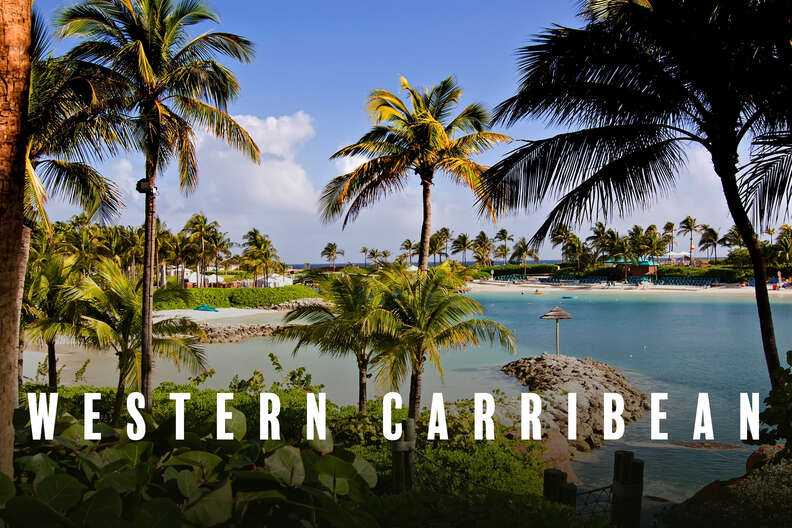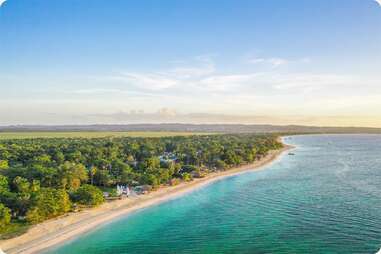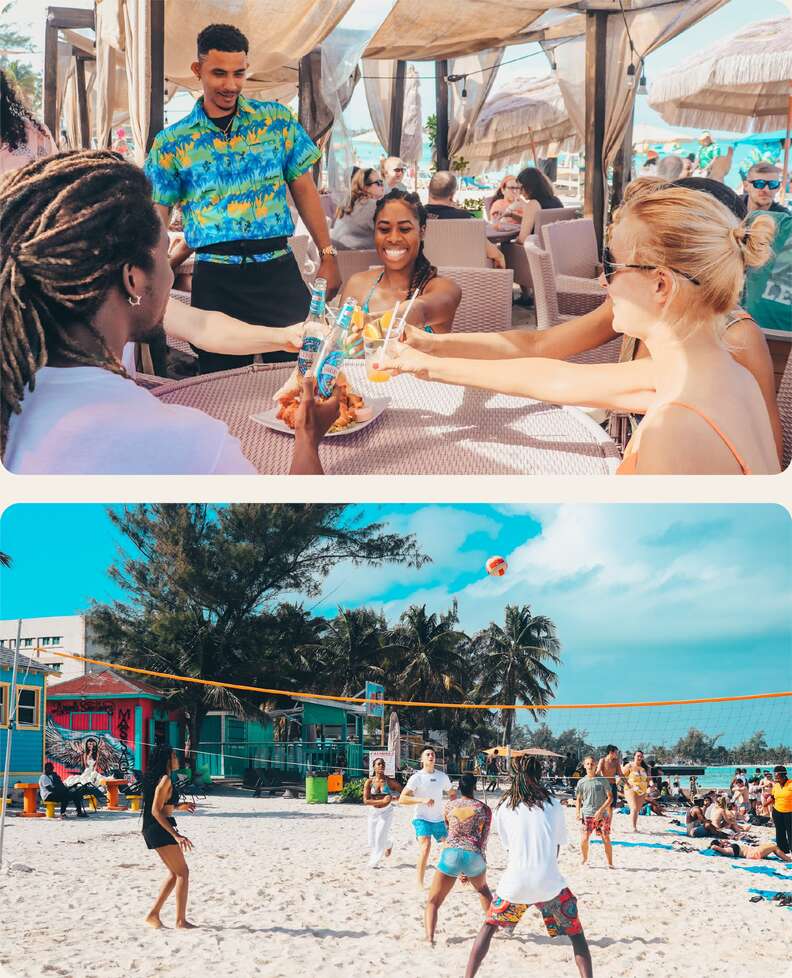
A Port-by-Port Guide to the Western Caribbean's Natural Wonders
Island magic, a town called Hell, and beekeeping missions await minutes beyond these cruise ports.
Some of the world’s most remarkable beaches. Flavor-packed local cuisine and irresistible cocktails. Music, history, and serene nature at every turn. The islands that make up the Western Caribbean region are truly some of the most enchanting places on the planet–and all of them are also home to bustling port cities that make them easy to explore.
Three of the region’s most popular port destinations—Nassau, Bahamas; Falmouth, Jamaica; and George Town, Cayman Islands—make up a “golden circle” that is a favorite of both cruise lines and travelers for good reason.
Nassau is where Bahamian swagger meets old-world charm. Pirate lore abounds amid pastel colonial architecture, while the air carries the scent of the day’s freshly caught seafood.
Falmouth is a quiet Jamaican port town that makes you feel like you’ve stepped into a reggae dream. Just beyond town are dense rainforests and refreshing waterfalls.
In George Town, underwater worlds and an upscale ambiance on land delight. In a one-day swoop, you can snorkel alongside neon fish while exploring coral reefs, swim among friendly stingrays, or shop to your heart’s content.
These destinations are distinctly vibrant, pulsing with local flavor and culture all at your fingertips just beyond the dock. Here’s how to make the most of your visit.
Don’t leave this nook of the Caribbean until you...
See: Amid Nassau’s high-end boutiques and more tourist-heavy haunts, the Straw Market offers Bahamian-made keepsakes crafted from conch shells, wood and, you guessed it, local straw. Pro tip: Take the vendors’ haggling as part of the charm. Politely decline if you’re not interested in a stall and move on to the dozens of other options.
Touch: The white sands with your toes at West Bay Beach, just north of the heavily trafficked Seven Mile Beach in George Town. Quiet moments, aqua blue and yellow pavilions for lounging and a picturesque, simplistic wooden pier for selfies await.
Smell: Bursts of papaya, plantains, coconuts and sugarcane at the Hamlin Stephenson Farmer’s Market in George Town. Mix-and-match for a smoothie and take home some hot sauce.
Hear: Junkanoo jams on the daily at Lukka Kairi Restaurant, a quick stroll from Nassau’s port. Enjoy tapas-style island fare and delightfully minty mojitos among other hand-crafted cocktails while sitting on an Indigenous-made wooden stool.
Taste: A Jamaican staple, the almighty Jamaican patty. Beyond the immediate stalls near the port, pop in to Juici Patties, a local favorite in Falmouth. Beyond the traditional beef offering, shrimp and plant-based varieties are also available, all tucked in light, flaky soft orange-hued dough pockets.

Things to do in Nassau, Bahamas
There are 700 total islands in the Bahamas, 30 of which are inhabited and only one of them home to its crown jewel and capital city: Nassau. Turquoise waters surround its core as modern luxury and colonial architecture commingle. A haven for pirates in the 18th century, this is where the famed Blackbeard once ruled the waters. Whether you’re at the Pirate Museum to various attractions throughout the city, you’ll never be far from a pirate-themed tchotchke in Nassau. At Fort Charlotte, you can literally walk through the tunnels that pirates once roamed.
This free-wheeling spirit still reigns in Nassau today, in the form of go-with-the-flow vibes, innovative island fare and memorable sips from locally crafted rum to wine. It’s the quintessential Caribbean juxtaposition of island time meets a visibly bustling city. For foodies, it’s bliss that spans the street food to fine dining spectrum. A short walk from Atlantis Paradise Island across the bridge to downtown covers everything from a top-tier steakhouse (Seafire) to mom-and-pop shacks selling conch salad. While each Bahamian island offers its own pizzazz, Nassau truly is the best of it all.

Morning – Stroll by caverns and sinkholes at a national park. For an adventure within a 30-minute taxi of Nassau’s cruise port, you can immerse yourself in Bahamas’ wilderness at Primeval Forest National Park. The landscape oozes with limestone caves, sinkholes and native plants, all of which can be experienced along its main walking loop, a one-mile, mostly flat trek.
Noon – Food shack hop en route to Atlantis. Hidden gems aplenty await on the southside of the bridge leading to Atlantis. Among your spots to prioritize are Mckenzie’s Fresh Fish & Conch for a ceviche-like conch salad and The Midnight Spot for a flash-fried grouper. If you haven’t tried the local beer by now, Kalik, snag an icy one. End your stroll at Atlantis and through the boutiques at its Marina Village. Give some casino games a spin inside Atlantis, if you’re feeling lucky.
Afternoon – Tour a Nassau distillery staple. A Nassau staple since 2003, this distillery in a vibrant red mansion offers free tours daily. There’s a tasting at the end—for a fee—offering up four-or-so options. If you’re a wine lover, hit the nearby Graycliff Wine Cellar instead. Fun fact: It has the world’s third largest wine cellar and, go figure, a massive wine selection to match.
Evening – Jam to some Junkanoo at a tiki hut. Within a 20-minute walk of the cruise port, Tiki Bikini Hut comes alive at night with music, dancing and, on weekends, steel pan players and Calypso singers. The hut is nestled right off Junkanoo Beach, bearing the name of the Bahamas’ biggest annual carnival, which takes place the day after Christmas, on New Year’s Day, and on various Saturdays throughout the year.

Things to do in Falmouth, Jamaica
Compared to bustling Nassau, Falmouth is a pocket-sized town, with a year-round population of less than 10,000. Georgian architecture, bright pastel buildings, and the most pristine of white sand beaches fill the landscape while green mountains loom in the distance. It’s nestled on Jamaica’s northern coast, with the tourist hotspot of Montego Bay just a 45-minute drive west.
With its unique geography, Falmouth was once a sugar and rum trade standout, making it one of the wealthiest towns in the Caribbean. Today, it is very much a port town, attracting the largest of cruise ships that serve as its ever-changing, tallest skyscrapers. Just beyond the town is a cornucopia of naturistic wonders. The thrills come in the form of secluded beaches, tropical rainforests, and one of the very few bioluminescent bays in the entire Caribbean. For nature lovers, Falmouth and its surroundings will satisfy, while the food and drink-motivated will delight in the locally crafted rum and a Jamaican patty (or five).

Morning – Soak up the vibes on Red Stripe Beach. This beach has no affiliation with the famous beer but bears its same name. It’s a solid public beach option, often with vendors selling coconut water and snacks. If you’re seeking chairs, a bar and Wi-Fi, 876 Beach Club is nearby, and access is just $10.
Afternoon – Gawk at timeless architecture in Falmouth’s historic district. Back near the port, Falmouth’s designated historic district dates back 250-plus years, with visible homages to times past. If the Georgian architecture and cobblestone streets don’t charm you, some of its cultural landmarks will.
Among them, William Knibb Memorial Baptist Church is named after a Jamaican-bred hero of the abolitionist movement. Knibb was an England-bred Baptist minister who was at the forefront of fleeing the slaves whose labor was responsible for the town’s sugar and rum wealth. Knibb’s namesake church now stands among the tallest buildings in town. The Falmouth Courthouse is also among Falmouth’s centerpieces thanks to its vibrant yellow hue with stately white columns. Both sites are as low key as the town itself and have no entry fees.
Evening – Take luminous laps. There are only a half-dozen or so bioluminescent bays in the Caribbean and one is right off Falmouth’s shores. Luminous Lagoon is like floating in a starry sky at night, with millions of microorganisms glowing when the water is splashed. Glistening Waters is a popular local tour operator that knows exactly where to go in the bay to experience the phenomenon firsthand.

Things to do in George Town, Cayman Islands
Situated on the western edge of Grand Cayman—the largest of the nation’s three islands—George Town is a history-filled oasis that’s home to 40,000 people. On the historical front, George Town was where pirates like Henry Morgan stashed his loot in caves and where sailors would trade sea turtles for their meat.
You can experience all of its rich history at the Cayman Islands National Museum. Otherwise, for a dose of today, you’ll see George Town’s skyline is a bit bigger and boxier compared to other port cities. That’s because, in part, this is a financial hub for much of the Caribbean, and an offshore banking destination for many across the world. Amid the big business façade, George Town and its surroundings offer secluded caves, cozy tiki bars, and a unique excursion to, well, Hell.

Morning – Buzz over to a beekeeping tour. Start your day taking in George Town’s lush rural landscapes at Reagan’s Honey, which offers beekeeping tours within a 20-minute taxi of the port. Tours are offered daily at 9 am and typically last an hour. As part of the experience, you’ll don a beekeeper suit, encounter iguanas, inspect an active beehive, and take home a jar of honey of your own.
Noon – Get your pickleball fix in. Less than a five-minute taxi ride from the port, you’ll find 12 shaded courts and then some for getting your pickleball fix. Pickleball Cayman is where you and your squad can dink away. The spot welcomes cruise guests and has coaches available for lessons. Just make sure to book your sessions in advance. If you didn’t happen to pack your own paddle, the on-site pro shop offers equipment to buy or rent.

Afternoon – Explore seven miles of sand before heading to Hell. Hugging the west coast of Grand Cayman is Seven Mile Beach, one of the Caribbean’s most prized beaches. Expect crystal-clear waters, banana boat rides and white sands. Whichever square of sand you lay a towel on will be bliss. If you’ve soaked up enough rays, continue north to Hell. Yes, Hell is the area’s name, with limestone formations, a “Welcome to Hell” gift shop and plenty of Hell-signed things for the perfect photo op.
Evening – Dabble in daiquiris at a tiki bar. For frozen daiquiris with a view, Sandbar is it. Watch the sun set over aqua waters and then see the skyline sparkle as night falls. Grand Tiki is also great for lounging, with a turf-floored patio and picnic tables overlooking the water, and tantalizing tiki cocktails.

What to know before you go
The currency
Pay by credit card to keep things seamless, ideally using a card with no international fees. US dollars are widely accepted across all three destinations. Be warned that if you withdraw or accept change in local currency (Bahamian dollars, Jamaican dollars and Cayman Island dollars), it may be incredibly difficult to exchange back home as, for example, Bahamian dollars carry the same value as US dollars and virtually zero bank or exchange houses carry or accept them.
International adapters you’ll need
No power adapters needed here—these destinations use the same voltage and outlets (110V) as the US.
When to plan your visit
Winter and early spring (December through April) boast the driest stretches and most pleasant temperatures, with highs in the lower 80s. June through November marks the Atlantic hurricane season, so if you are traveling during these months, you can count on fewer crowds, but keep an eye on developing or looming storms.
Your fun Western Caribbean dinner party fact
Beyond the Cayman Islands, there are also places called George Town in Tasmania, Malaysia, India, and Liberia. There’s a Georgetown University in Washington DC, too, but that’s spelled differently.
